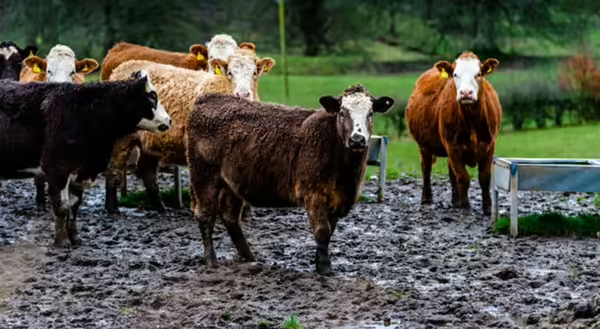
Wet, cold weather continues to persist in Illinois. Naturally, these conditions create mud. Muddy conditions are rather difficult to navigate on the cattle farm. These conditions can be frustrating for the farmer and the cattle. Challenges associated with mud on the cattle farm need to be identified and evaluated to ensure the environment is not detrimental to animal health and performance.
Challenges
One of the downfall's to mud is the increase in energy requirement for cattle to navigate the terrain. After all, when you "boot up" and head out to tromp through the mud you are using more energy to travel the same distance through mud too. As you track through muddy lot you are normally out of breath and tired. Same goes for cattle… they are getting a workout too.
The added energy needed results in less going to weight gain and performance. In 1991, University of Nebraska researchers published common numbers associated with loss of gain due to mud.
|
Mud depth |
Loss of Gain |
|
Dewclaw deep |
7% |
|
Shin deep |
14% |
|
Hock deep |
28% |
|
Belly deep |
35% |
University of Nebraska also published "Mud Effects on Feedlot Cattle" in 2011. This piece authored by Terry Mader, built a model and simulated conditions based on actual cattle feeding studies. The model showed under cold (16°F) and wet (6 in. rainfall for 120-day feeding period) conditions cost-of-gain was 56.1% higher than 26°F and no precipitation. Full article available here.
Another problem associated with extended muddy conditions is foot rot. Constant exposure to wet conditions can lead to breakdown of the skin around the hoof. This opens the tissues up to bacteria and can lead to infection. Swelling and lameness are usually the first signs that an animal has foot rot.
A dryer, less saturated area for cattle is the answer to maintain cattle performance and avoid health issues. Often times a pasture is considered as the savior. Stockpiled pastures with good drainage can be a big help. However, stocking too many animals in a small pasture area or the trailing of animals across pastures can cause disturbance of the soil. If tracked up, the forage stand will be reduced and opened to weed pressure in the following growing season.
Management
Managing mud is a tough task. Sure, everyone would love to have concrete feeding pads or facilities to get cattle up out of the mud. While these are options, they are expensive. If you continually are dealing with muddy conditions, they could be worth the investment. Geotextile fabric and rock will be a good investment for temporary or mid-term mitigation of muddy, wet conditions.
For those dealing with short term mud challenges, picking well drained areas of the farm to concentrate feeding is best. Also, de-stocking an area and spreading cattle out on cornstalk or tillable acreage temporarily may help. University of Illinois research conducted at the Dudley Smith research farm shows no negative agronomic effect to grazing cornstalks. Removing cattle from cornstalks in mid-winter to allow the freeze-thaw-freeze period to occur will help reduce compaction. Anyways, this is just another reason to have cows grazing cornstalks. If cows are trampling cornstalks, providing extra forage and supplement may be necessary. Don't over-stock these areas or mud and compaction could still be a problem.
Another option is to bed cattle. Straw, cornstalks, soybean stubble, wood chips, etc. help cattle stay up out of the mud. Cattle feeding areas exposed to the outdoors will likely need bedded. Be mindful that this may be a temporary solution as the more organic matter added to the pen can create more mud after time. Deep bed packs work well to keep building mounded areas for cattle to stay on "high ground." Lots of bedding will help, but it will also likely result in more manure hauling.
Managing mud is difficult. Frankly, it sucks. It makes for longer, dirtier chores and seems to slow everything down on the farm. While there is no silver bullet for getting cattle out of the mud, it can be managed to an extent. Here's to hoping we get a good freeze and some tame cold weather… so we can all benefit from "poor man's concrete."